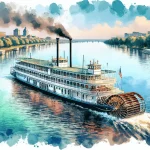Chester Arthur Burnett, better known as Howlin’ Wolf, was a towering figure in the blues and jazz realms, leaving an indelible mark on the lively music landscape of New Orleans. His distinctive growling vocals and electrifying stage presence made him a formidable force, captivating audiences with his raw, primal energy.
In This Article
TL;DR
- Howlin’ Wolf significantly influenced New Orleans’ unique sound, shaping the city’s music scene.
- Key collaborations and performances defined his career and solidified his legacy.
- His enduring impact has inspired generations of contemporary jazz and blues artists.
Early Life and Musical Beginnings
Born on June 10, 1910, in White Station, Mississippi, Howlin’ Wolf’s early years were immersed in the rich musical traditions of the Delta region. His grandfather’s tales of howling wolves inspired his iconic stage name, and his father’s gift of a guitar at age 18 ignited his passion for music.
Exposed to blues masters like Charley Patton and Sonny Boy Williamson II (his step-brother-in-law), Howlin’ Wolf honed his skills, absorbing their techniques and showmanship. His time in the U.S. Army, where he served as one of the last true cavalry soldiers, further shaped his unique perspective.
Rise to Prominence in New Orleans
Howlin’ Wolf’s arrival in New Orleans in the early 1950s marked the beginning of his ascent to stardom. His first major performances at venues like the Dew Drop Inn and the iconic Preservation Hall captivated audiences with his electrifying stage presence and powerful vocals.
As he developed his signature style, blending Delta blues with the energy of urban life, Howlin’ Wolf quickly gained a devoted following among local music enthusiasts and critics. His performances were a testament to his ability to captivate and enthrall, leaving an indelible mark on the city’s musical landscape.
Signature Musical Style and Performances
Howlin’ Wolf’s musical style was a unique fusion of raw, gritty blues and the infectious rhythms of jazz. His deep, gravelly vocals, often compared to the howling of a wolf, were complemented by his masterful harmonica playing and the driving beat of his backing band.
Key elements that distinguished his music included his use of call-and-response patterns, intricate guitar work, and a relentless energy that kept audiences on the edge of their seats. Performances like his legendary set at the New Orleans Jazz & Heritage Festival showcased his ability to command the stage, leaving a lasting impression on all who witnessed his artistry.
Collaborations and Influence
Throughout his career, Howlin’ Wolf collaborated with some of the most influential jazz and blues artists of his time. His partnerships with musicians like Muddy Waters, Willie Dixon, and Hubert Sumlin not only enriched his own sound but also influenced the trajectories of their respective careers.
These collaborations fostered a cross-pollination of ideas and styles, further cementing Howlin’ Wolf’s impact on the New Orleans music community and beyond. His influence extended far beyond the city’s borders, inspiring generations of musicians and shaping the evolution of blues and jazz genres.
Recording Career and Notable Works
Howlin’ Wolf’s discography is a testament to his enduring legacy. From his early recordings on the Chess Records label to his later works like “The Howlin’ Wolf Album,” his albums and singles captured the raw energy and emotional depth of his performances.
Albums like “Moanin’ in the Moonlight” and “Howlin’ Wolf” showcased his ability to blend traditional blues with contemporary influences, exploring themes of love, loss, and the human experience. His recordings not only preserved his unique sound but also served as a blueprint for future generations of musicians.
Howlin’ Wolf’s Contribution to Jazz and Blues
Howlin’ Wolf’s role in the evolution of jazz and blues cannot be overstated. His innovative approach to blending genres and his ability to captivate audiences with his electrifying performances set him apart from his contemporaries in the New Orleans scene.
His influence can be heard in the works of modern musicians across various genres, from rock to hip-hop, as they draw inspiration from his raw, authentic style. Howlin’ Wolf’s contributions have left an indelible mark on the fabric of American music, ensuring his legacy will endure for generations to come.
Legacy and Continuing Influence
Today, Howlin’ Wolf is remembered as a true icon of the New Orleans music scene and a pioneer of blues and jazz. His legacy is celebrated through tributes, awards, and recognition from institutions and organizations worldwide.
The Howlin’ Wolf Foundation, established by his step-daughter Bettye Kelly, works tirelessly to preserve and extend his legacy, ensuring that his music and influence continue to inspire new generations of artists. From live tribute shows to cover bands and guided listening sessions, there are numerous ways for music enthusiasts to deepen their appreciation for this legendary figure.
Engaging with Howlin’ Wolf’s Music Today
For those seeking to immerse themselves in the world of Howlin’ Wolf, there are numerous avenues to explore. His music can be found on various streaming platforms and physical releases, allowing listeners to experience the raw power of his performances.
Live tribute shows and cover bands, such as the renowned Howlin’ Wolf Revue, offer the opportunity to witness his music brought to life on stage, capturing the energy and spirit of his legendary performances. Additionally, guided listening sessions and educational programs provide a deeper understanding of his techniques, influences, and lasting impact on the world of music.
By engaging with Howlin’ Wolf’s music and legacy, one can truly appreciate the enduring power of his artistry and the indelible mark he left on the vibrant tapestry of New Orleans’ jazz and music scene.






